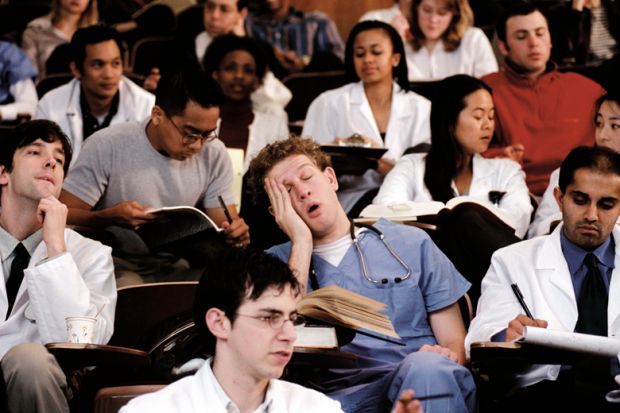If you’ve ever found yourself nodding off during a conference, you might be relieved to hear that it might not be your fault – or that of the speaker.
A growing body of evidence suggests that poor ventilation in the spaces typically used for conferences results in a build-up of carbon dioxide levels that can lead to poor concentration and drowsiness among the people gathered.
Now, an academic is embarking on a one-man mission to boost the alertness of scholars at conferences the world over.
Adam Ginsburg, a Jansky fellow at the US National Radio Astronomy Observatory, began measuring carbon dioxide levels at academic events after a colleague pointed out a ventilation problem in his own office.
What he discovered was that many venues used for conferences, business meetings and similar events had inadequate ventilation. When large numbers of people assembled in an enclosed and poorly air conditioned space, carbon dioxide levels could rise to potentially dangerous levels.
A normal concentration of carbon dioxide in a healthy outdoor environment is commonly considered to be between 250 and 350 parts per million of air particles (ppm). Anything between 1,000ppm and 2,000ppm is associated with drowsiness and poor air quality, and the European standards agency has set a strict limit of 3,500ppm for buildings and public places.
At one academic conference in a hotel basement in Greece last year, however, Dr Ginsburg measured carbon dioxide levels in the 2,000-2,500ppm range, “which was absolutely awful”, he said.
And at a scientific conference held last year in Finland, Dr Ginsburg measured a steady rise in CO2 levels from 786ppm at the beginning of one session to 1,390ppm an hour later.
When conference organisers opened windows, however, carbon dioxide remained at a steady level.
“I don’t think you can blame the organisers so much as the venues,” said Dr Ginsburg, because “many venues aren’t meant to hold as many people as we squeeze in”. Some hosts were still reluctant to open venue doors and windows, however, because the noise and light could cause distractions.
Some eight studies in the past seven years have examined how accumulating carbon dioxide affects people. One experiment by scientists at the Lawrence Berkeley National Laboratory, published in Environmental Health Perspectives, exposed subjects to carbon dioxide levels between 600ppm and 2,500ppm before asking them to take a problem-solving test.
The researchers found that the higher the levels of carbon dioxide the subjects were exposed to, the worse they performed on the test – with scores significantly lower in rooms with levels above 1,000ppm.
Dr Ginsburg said he planned to continue to collect and report carbon dioxide levels at academic conferences because “it clearly motivates organisers to better ventilate the room”. “Measuring the CO2 levels seems like a generally good idea if there’s not a good air conditioning system in place,” he advised. “If nothing else, it tells you when everyone needs a coffee and a breath of fresh air.”
POSTSCRIPT:
Print headline: Fresh air clears the cobwebs in conferences
Register to continue
Why register?
- Registration is free and only takes a moment
- Once registered, you can read 3 articles a month
- Sign up for our newsletter
Subscribe
Or subscribe for unlimited access to:
- Unlimited access to news, views, insights & reviews
- Digital editions
- Digital access to THE’s university and college rankings analysis
Already registered or a current subscriber? Login







